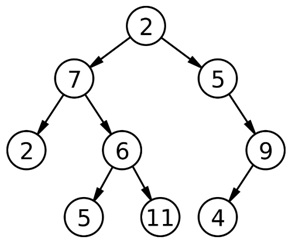数据结构树二叉树计算节点
Algorithm:
算法:
One of the popular traversal techniques to solve this kind of problems is level order tree traversal (Read: Level Order Traversal on a Binary Tree) where we use the concept of BFS.
解决此类问题的一种流行的遍历技术是级别顺序树遍历(阅读: 二叉树上的级别顺序遍历 ),我们使用BFS的概念。
The basic idea to solve the problem is:
解决问题的基本思路是:
Do a level order traversal and check whether the processed node has its left and right child both NULL.
进行级别顺序遍历,并检查已处理节点的左,右子节点是否均为NULL 。
If the processed node has its left and right child both NULL, it’s a leaf node.
如果处理后的节点的左右子节点均为NULL,则为叶节点。
Increase leaf node count
增加叶节点数
Pseudocode:
伪代码:
struct BT{ // tree node type
int data; //value
struct BT *left; //pointer to left child
struct BT *right; //pointer to right child
};
int noofleafnodes(struct BT *root){ // root of the tree
// BT refers to node of tree (datatype for the node);
struct BT *temp;
struct Queue *q=Creat_queue(); //creating a queue
int count=0;
if(!root) //root is null
return;
//**using level oder search**
EnQueue(q,root); // Enqueue the root in the queue
while(!emptyQueue(q)){
temp=DeQueue(q); //Dequeue
// processing the node and checking whether both child nodes are NULL or not
if(!temp->left && !temp->right)
//increase no of leaves count if both child nodes are NULL (ensures it's a leaf node)
count++;
else{
if(temp->left)
EnQueue(q,temp->left); // if left child exists EnQueue
if(temp->right)
EnQueue(q,temp->right); // if right child exists EnQueue
}
}
DeleteQueue(q);
return count; // return no of leaf nodes
}

Image source: wikipedia
图片来源:Wikipedia
Example:
例:
The leaf nodes in the above tree is 2, 5, 11, 4
上面树中的叶节点是2、5、11、4
C++ implementation:
C ++实现:
#include <bits/stdc++.h>
using namespace std;
class tree{ // tree node is defined
public:
int data;
tree *left;
tree *right;
};
int noofleafnodes( tree *root){
queue<tree*> q; // using stl
tree* temp;
int count=0;
q.push(root);
while(!q.empty()){
temp=q.front();
q.pop();
//process node and check wheather leaf node or not
if(!temp->left && !temp->right){
count++;
cout<<temp->data<<" ";
}
if(temp->left)
q.push(temp->left); //EnQueue
if(temp->right)
q.push(temp->right); //EnQueue
}
cout<<endl;
return count;
}
tree* newnode(int data) // creating new node
{
tree* node = (tree*)malloc(sizeof(tree));
node->data = data;
node->left = NULL;
node->right = NULL;
return(node);
}
int main()
{
//**same tree is builted as shown in example**
int c;
tree *root=newnode(2);
root->left= newnode(7);
root->right= newnode(5);
root->right->right=newnode(9);
root->right->right->left=newnode(4);
root->left->left=newnode(2);
root->left->right=newnode(6);
root->left->right->left=newnode(5);
root->left->right->right=newnode(11);
cout<<"printing the leaf nodes......"<<endl;
c=noofleafnodes(root);
cout<<"no of leaf nodes is : "<<c<<endl;
return 0;
}
Output
输出量
printing the leaf nodes......
2 5 11 4
no of leaf nodes is : 4
翻译自: https://www.includehelp.com/data-structure-tutorial/find-the-number-of-leaf-nodes-in-a-binary-tree.aspx
数据结构树二叉树计算节点








![enumerate_Java Thread类的static int enumerate(Thread [] th)方法与示例](http://pic.xiahunao.cn/enumerate_Java Thread类的static int enumerate(Thread [] th)方法与示例)



)






